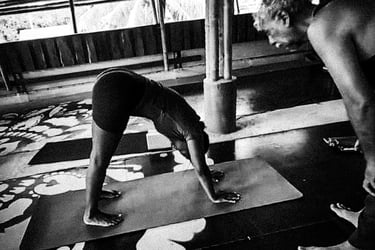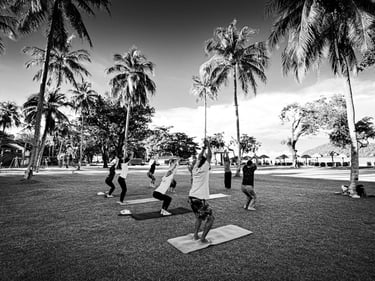Yoga Lineages


Many yoga terms can be confusing for beginners, and it's not just because of the Sanskrit! Take “Mudra,” for instance. It can refer to hand gestures, but there are also poses that go by the same name, like “Yoga Mudra.” Similarly, there’s a pose called Ashtanga Namaskar, but there's also a whole style of yoga called Ashtanga Vinyasa. It can feel a bit overwhelming at first for beginners.
Yoga Lineages
The modern understanding of yoga comes from a mix of different traditions rather than a single source. While these traditions have evolved over centuries, but the original texts that shaped yoga fell into obscurity for long periods. However, a resurgence in the 19th century led to the revival of many practices, giving rise to the lineages we know today.
Here’s an overview of some prominent lineages, tracing the historical progression and connections:
Hatha Yoga Lineage
Bihar School of Yoga (Satyananda Tradition): Founded by Swami Satyananda Saraswati, a student of Swami Sivananda, this style blends Hatha Yoga with Tantric and Vedantic ideas. It includes Yoga Nidra, Kriya practices, and meditation, placing emphasis on physical aspects alongside spiritual growth. These physical aspects form the foundation of most physical yoga postures practised today, making Hatha Yoga a key starting point for anyone exploring yoga.
Sivananda Yoga: Established by Swami Sivananda, this tradition emphasises five principles - exercise, breathing, relaxation, diet, and meditation - balancing asanas with a spiritual approach.
Iyengar Yoga: Developed by B.K.S. Iyengar, this lineage focuses on alignment and precision in asana, often using props to perfect the poses. Iyengar Yoga is closely related to Vinyasa Yoga through its roots in T. Krishnamacharya's teachings.
Vinyasa Yoga Lineage
Krishnamacharya Lineage: T. Krishnamacharya is often regarded as the father of modern yoga. He taught influential figures like Pattabhi Jois and B.K.S. Iyengar, laying the groundwork for Vinyasa Yoga, which synchronises breath with movement. This lineage is the precursor to Ashtanga Vinyasa Yoga.
Ashtanga Vinyasa Yoga: Developed by Pattabhi Jois, this style is known for its set sequences of postures that build in difficulty, encouraging a disciplined and physically demanding practice.
Kundalini Yoga Lineage
Yogi Bhajan Tradition: This style focuses on awakening kundalini energy through breathwork, meditation, chanting, and dynamic movements, merging spiritual and physical practices.
Tantra Yoga Lineage
Kaula Tradition: This ancient path centres on balancing inner energies through rituals, mantras, and visualisations, aiming to align the individual with universal consciousness.
Sri Vidya: A Tantric path that worships the Divine Mother (Shakti), merging meditation, mantra, and devotion to connect with divine energy. It is more of a philosophical and devotional system compared to Hatha or Vinyasa yoga.
Kriya Yoga Lineage
Paramahansa Yogananda Lineage: Made famous by Autobiography of a Yogi, this lineage focuses on Kriya Yoga, combining breath control and meditation for self-realisation.


Modern and Contemporary Evolutions
Not all yoga lineages are named after geographical locations like Bihar or Mysore. Another tradition is Yantra Yoga (of Tibet) which also developed from ancient traditions based on similar ideas. Others draw their names from founders, philosophies (Kundalini Yoga, Bhakti Yoga), or specific teachings.
In more contemporary contexts, practices such as Yin Yoga and Insight Yoga (by Paul Grilley and Sarah Powers) have emerged, offering slower-paced and introspective approaches to practice. Kripalu Yoga, which evolved in the United States, also integrates principles from various traditions, especially Kundalini Yoga.
Additionally, breathing techniques in the Wim Hof Method bear a strong resemblance to the Tummo technique of Tibet, illustrating how modern practices can be inspired by ancient traditions.
These developments represent how different yoga practices have evolved and been tailored to meet the diverse needs of practitioners worldwide, all while retaining the essence of the mind-body connection.
Final Thoughts for Beginners
If you’re feeling overwhelmed by the many names and styles, it’s important to remember that all yoga traditions have something valuable to offer. Whether you’re drawn to the physical postures, breathing techniques, or spiritual elements, there’s a lineage that will speak to your needs. Starting with a style like Hatha Yoga can be a good way to explore the physical aspects, which serve as the foundation for most modern yoga practices.
Yoga is a journey, and as you explore these lineages, you’ll discover which practice resonates with you. There’s no right or wrong starting point - just begin where you feel comfortable, and let your practice evolve naturally.
Further Reading
Metaphors & Models : Translating Complex Subjects
Chakras & Energy Distribution : Maintaining free flow
More Insights
